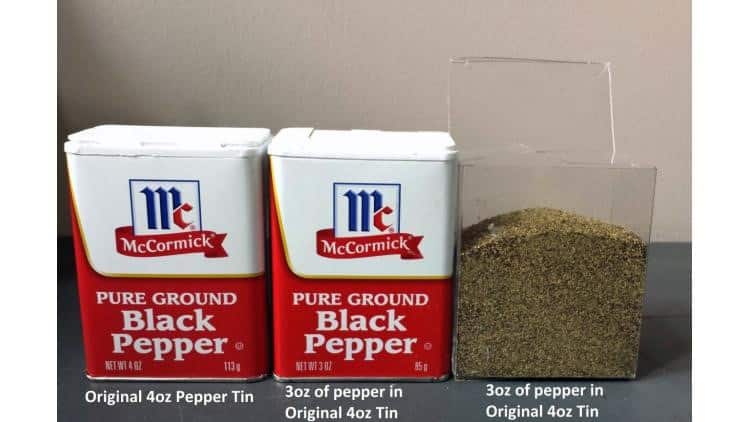Earlier this month, CosmeticObs posted this article written by Dr Frédéric Lebreux, our COO, about the Nonfunctional Slack Fill.
Here is the translated article.
The Frog that wants to make itself as big as beef: phenomenon of the “Nonfunctional Slack Fill” in the cosmetic industry
Let us remember our tender years during which opening our curiosity to the world and to its wonders was enough to meet all expectations. At that time, Jean de La Fontaine’s common sense and exemplary morals more or less contributed to building the reasonable human being that we have become. His fables are still very topical and re-reading them at any age is never a waste of time. One of them begins with these few lines:
A Frog saw a beef
Which seemed to him of good size.
She who was not as big as an egg,
Envious stretches, and swells, and works
To match the animal in size,
Transposed to consumer products, the crazy enterprise of this small amphibian refers to the concept of “nonfunctional slack fill”, a concept that consists in leaving an unnecessary empty space in a container or a packaging. Surprisingly enough, this subject seems to be little discussed within the European cosmetic industry.
Let’s be clear: the economic actor resorting to this practice of deceiving the consumer into giving him the illusion of abundance is not acting out of vanity and there ends the analogy with poetry. When, without possible technical justification, a non-transparent container is insufficiently filled or when the size of the container is not in relation to the one of its packaging, it is, without doubt possible, the economic logic that prevails. The method is worn out: because the consumer is too sensitive to a price increase for a given product, we choose instead to decrease the quantity of the product present in each unit. Some consumers are attentive to this aspect, so care should be taken to keep a container or packaging of identical size in order to make the operation as discreet as possible. This is not the only scenario leading to the nonfunctional slack fill but it is probably one of the most common.
In 2015, the spice maker McCormick was sued by Watkins, one of its main competitors, over its crushed black pepper. As illustrated below, McCormick had suddenly reduced the content of its flagship product by 25% but without changing the size of the container. The new container indicated the new nominal content (3 ounces instead of 4), but McCormick was careful not to advertise this change.

This example is deliberately drawn from the food industry, but giants in the cosmetic world have also been pinned down in recent years for similar facts, mainly in the United States. The scourge of non-functional slack fill affects all industries and it would have been surprising that cosmetic brands were miraculously spared.
Note that there are many examples where the slack fill is justified by its function and, for example, the content protector. Of course, the devil is in the details and there is a whole continuum of intermediate situations in which the slack fill is both necessary but oversized and to varying degrees.
Of course, this practice can permanently damage the reputation of a brand and damage the confidence that consumers have in it. However, and beyond this marketing aspect, it should not be forgotten that a regulatory framework exists and that failure to comply with it can lead to serious legal problems – in particular, to fines whose amounts include six digits or more. Unfortunately for some, luckily for others, this regulatory framework is generally not very prescriptive and leaves it to the economic actor, the Competent Authorities and consumers to exercise their capacity of judgement.
In the United States, the United States Code indicates in section 362 (d) relating to mislabeling of cosmetic products (misbranded cosmetics) that a cosmetic product is considered to be mislabeled if its container is manufactured, formed or filled in a misleading way.
Aside from food, the FDA has never seen fit to clarify this very costly law through the adoption of implementing regulations. However, we can cite (or even take inspiration from) what has been produced to better regulate the food industry (21 CFR§100.100): a container that does not allow the consumer to fully see its content is considered to be misleading. it contains an unfilled and non-functional space. This space is the difference between the actual capacity of a container and the volume of product it contains. The unfilled and nonfunctional space is the empty space in a container that is filled less than its capacity for reasons other than (there follow six functional justifications allowing the use of slack fill).
In addition, the federal Fair Packaging and Labeling Act (15 USC§1471) authorizes the FDA and the FTC (Federal Trade Commission) to promulgate implementing regulations for cosmetic products. However, both the FDA and the FTC have declined the offer, leaving the cosmetics industry and consumers free to appreciate if there is a nonfunctional slack fill. Because it is true that the United States and the European Union differ widely as to how to protect the interests of consumers, the former giving the consumer the legal tools allowing him to defend himself when the latter relies on prescriptive rules and the oversight capacity of the Competent Authorities. This difference explains why many “Class actions” against cosmetic brands, brought to justice by consumers or their representatives, have been publicized in the United States in recent years when the subject has remained relatively discreet in Europe. It is notable, however, that the success of the plaintiffs is not guaranteed and that if large groups have indeed been condemned, the condemnation of the brand is not systematic.
At the European level, the regulatory framework is just as vague as that set up by the United States, but two channels should be considered, namely consumer rights and environmental protection.
Regarding consumer rights, the European Cosmetic Regulation (EC No 1223/2009), the Regulation defining the Common Criteria (EU No 655/2013) and the ARPP Recommendations do not provide any real clarification, the filling rate of ” a container or its packaging which cannot be assimilated to a marketing communication. Similarly, EEC Metrology Directive No 211/1976 does not rule on slack fill and is limited to relating the nominal content to the content actually present in the container. On the other hand, the Directive on unfair commercial practices EC No 29/2005 indirectly addresses the subject via its Article 5:
1. Unfair commercial practices are prohibited. 2. A commercial practice is unfair if: a) it is contrary to the requirements of professional diligence, and b) it alters or is likely to substantially alter the economic behavior, in relation to the product, of the average consumer whom it affects […].
Article 6 is perhaps even more precise since it describes what is a deceptive action and that this seems to include the practice of nonfunctional slack fill, even if the nominal content reported on the labeling were to be consistent:
1. A commercial practice is deemed to be misleading if […] in any way, including its general presentation, it misleads or is likely to mislead the average consumer, even if the information presented is factually correct, in which concerns one or more of the following aspects and [that] it leads or is likely to lead him to take a commercial decision which he would not have taken otherwise: […] b) the main characteristics of the product, such as […] its quantity, specifications, […].
Finally, Article 7 on misleading omissions could also be invoked when a product made available on the market comes to be modified in order to introduce a nonfunctional slack fill without prior warning to consumers.
Concerning the protection of the environment, and even if no quantified obligation is introduced, the European Directive relating to packaging and packaging waste CE No 62/1994 (Annex II, Section 1) is very explicit in the matter:
The packaging will be manufactured to limit its volume and weight to the minimum necessary to ensure the required level of safety, hygiene and acceptability for both the packaged product and the consumer.
This aspect is also implemented in the form of a bonus to environmental contribution. Indeed, and as mentioned in the Adelphe and CITEO declaration guides, there are eco-design bonuses linked to a reduction at the source:
A bonus of 8% is granted on the total contribution of UVC for the following actions:
• weight reduction to iso-material and iso-functionality;
• reduction in volume to iso-material and iso-functionality (for example by concentration of the product);
We therefore see that without really legislating on the subject, the European Union has been able to set up a fairly flexible framework aimed at proscribing or, at least, reducing the practice of nonfunctional slack fill. The mystery remains, however, as to the concrete implementation of these regulatory texts by the Competent Authorities, the means at their disposal to ensure market control and any infringements that they may have observed in the matter.
At the national level, concrete measures seem to have been taken by a few Member States and, in particular, by Germany, Belgium and Slovakia. As an example, let us quote the German law relating to prepackaging which provides in its Article 43§2 that:
It is prohibited to manufacture, cause to be manufactured, place within the scope of this Law, place on the market or otherwise make available on the market [prepackages] if their design and filling simulate a quantity of filling greater than that contained therein.
In practice, this Law leads to fairly strict obligations such as the following table showing the maximum ratios between the volume of the container and the nominal volume of skincare products:
| Nominal quantity in g or ml | Volumes ratio |
| 10 ≤ NQ < 25 | 3 : 1 |
| 25 ≤ NQ ≤ 50 | 2,5 : 1 |
| NQ > 50 | 2 : 1 |
Finally, and although not having any real legal value, we can mention the guidelines of WELMEC which is the body governing cooperation between the Legal Metrology Authorities of the Member States of the European Union and of EFTA. This document is certainly worth browsing and has the merit of giving an informed opinion on the subject.
In conclusion, the regulator has, barring exceptions, not provided for binding measures aimed at preventing the practice of nonfunctional slack fill – a practice that is both unethical and careless of the environment. Yet there is a legal framework which, at least in theory, should push the cosmetics industry to act honestly and responsibly. In this context, voluntary approaches are to be congratulated and we can only rejoice at the virtuous behavior of certain large enlightened market players who do not fail to lead by example. For the others, we can only recall the African proverb: “Who spends the night in the pond wakes up cousin of the frogs.”


